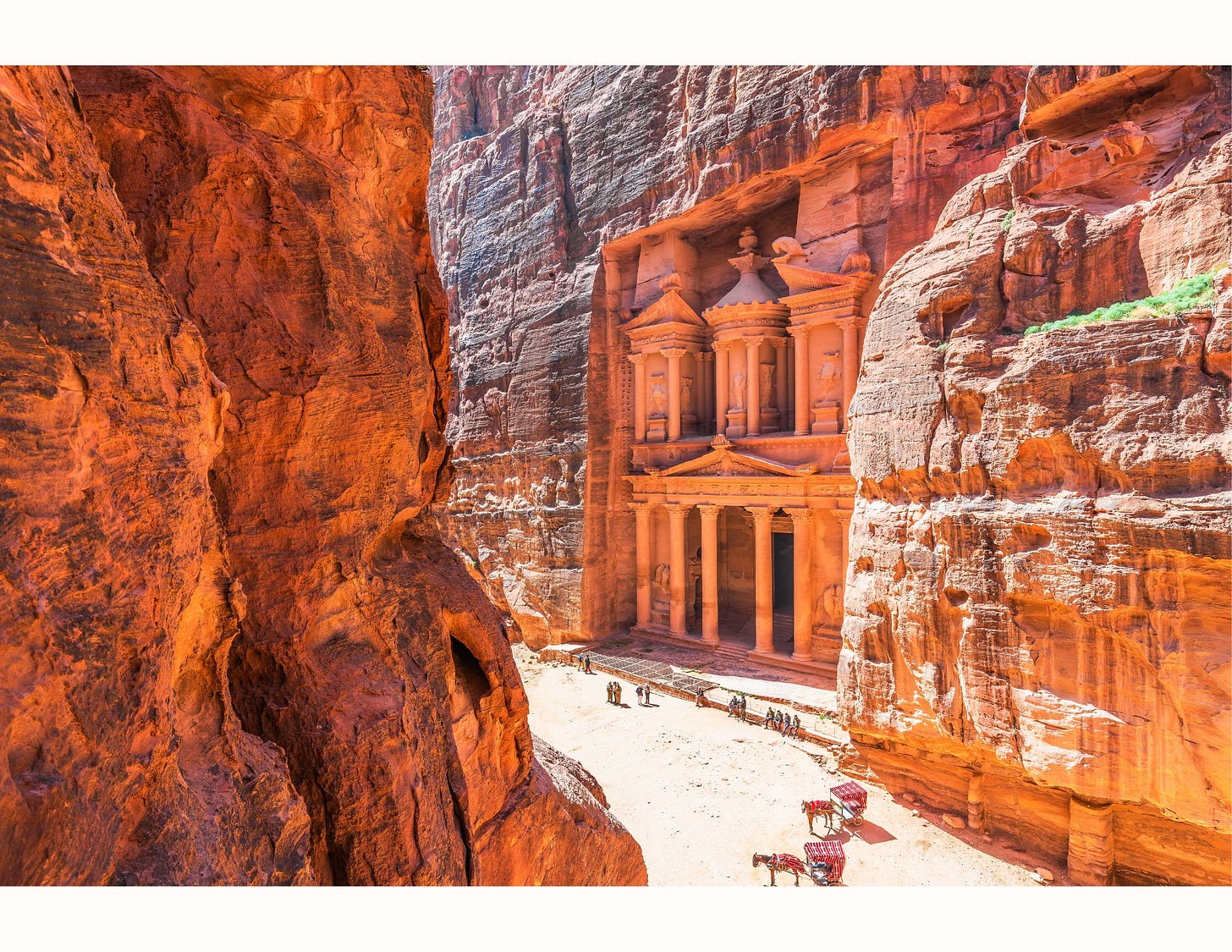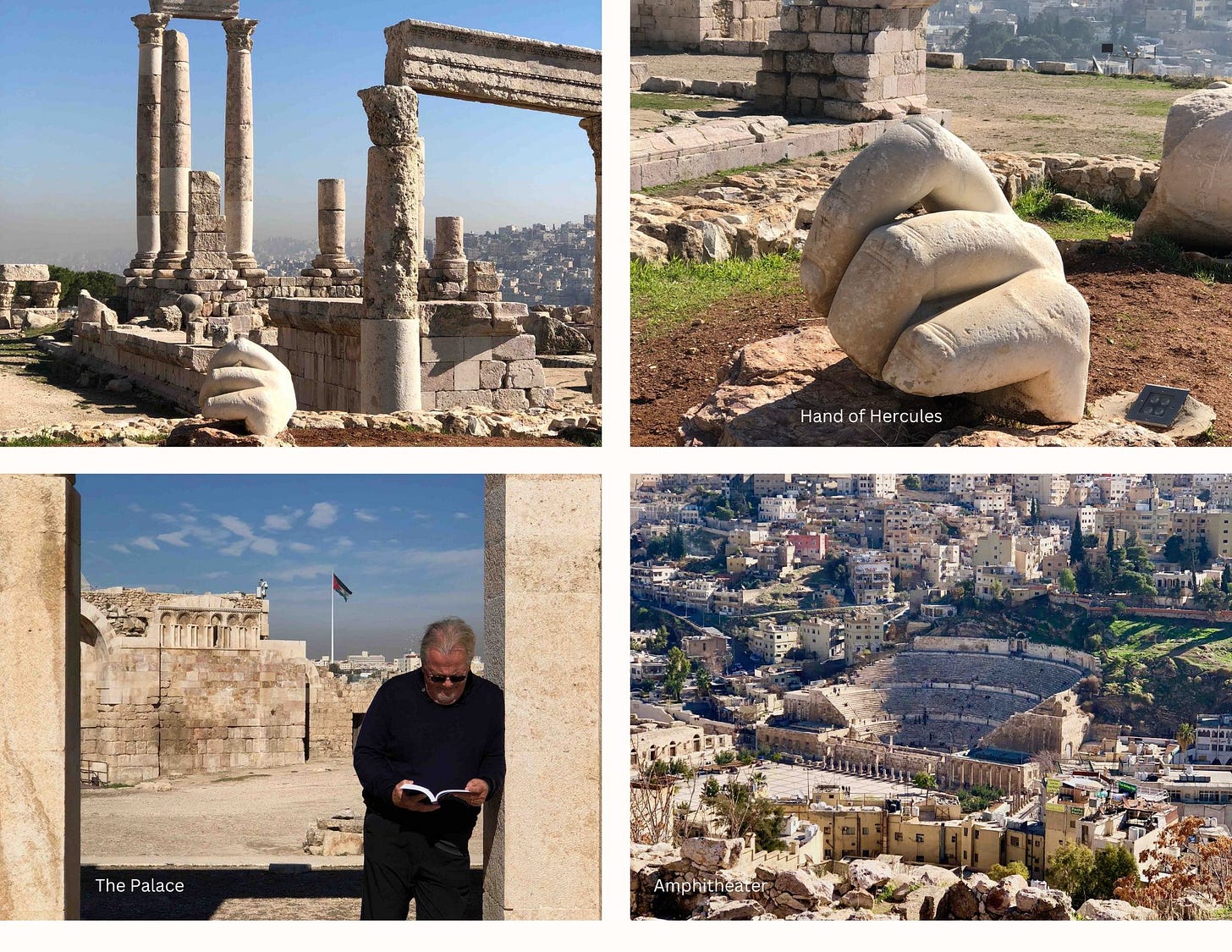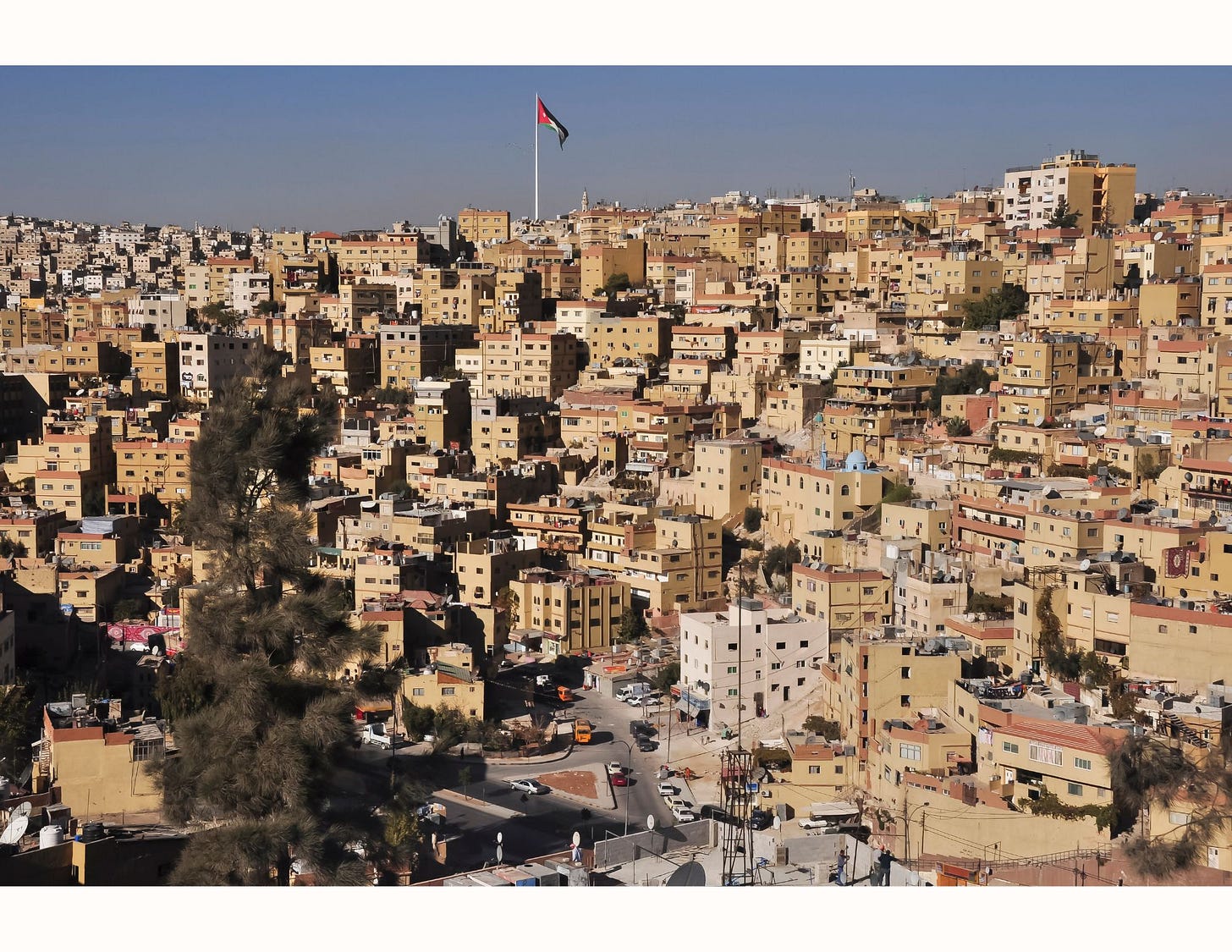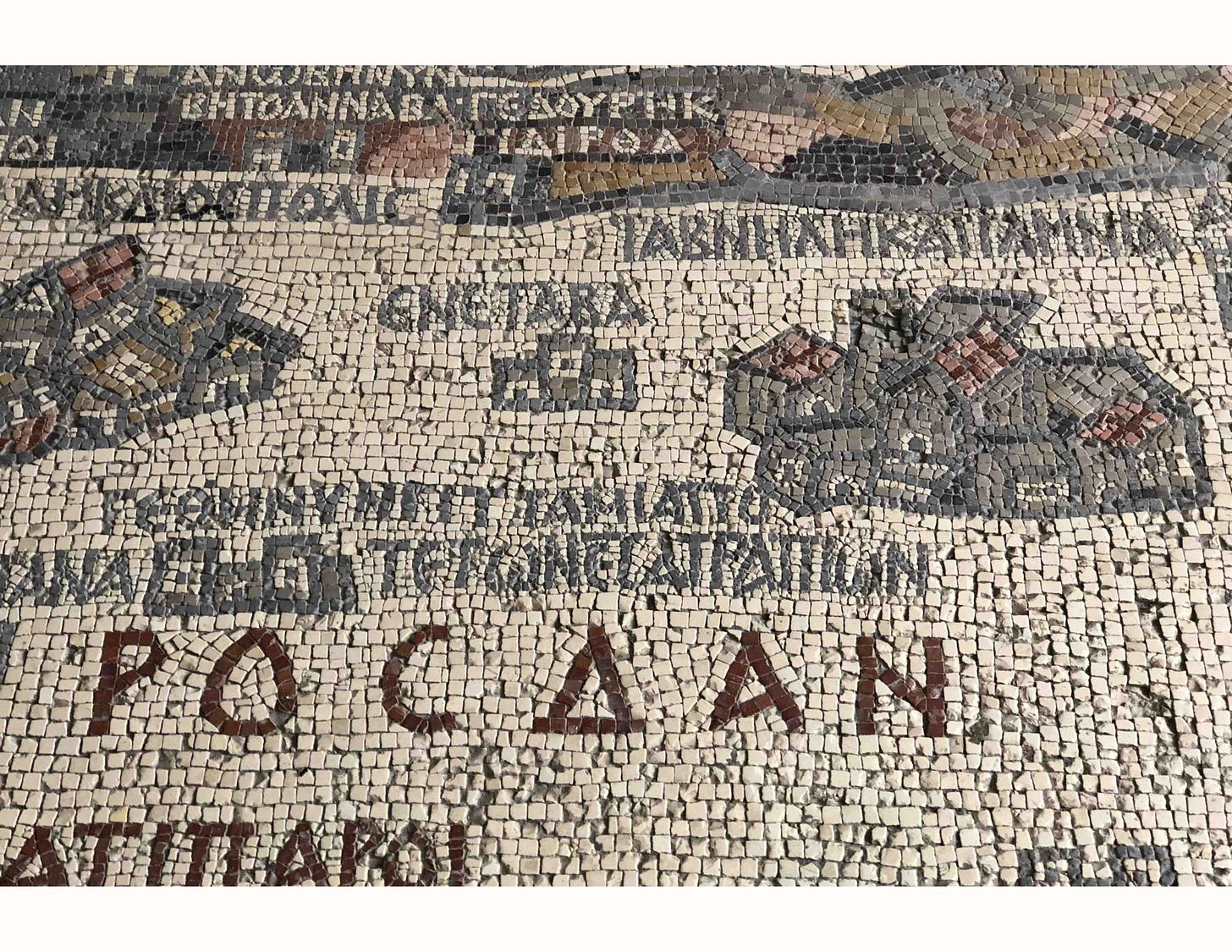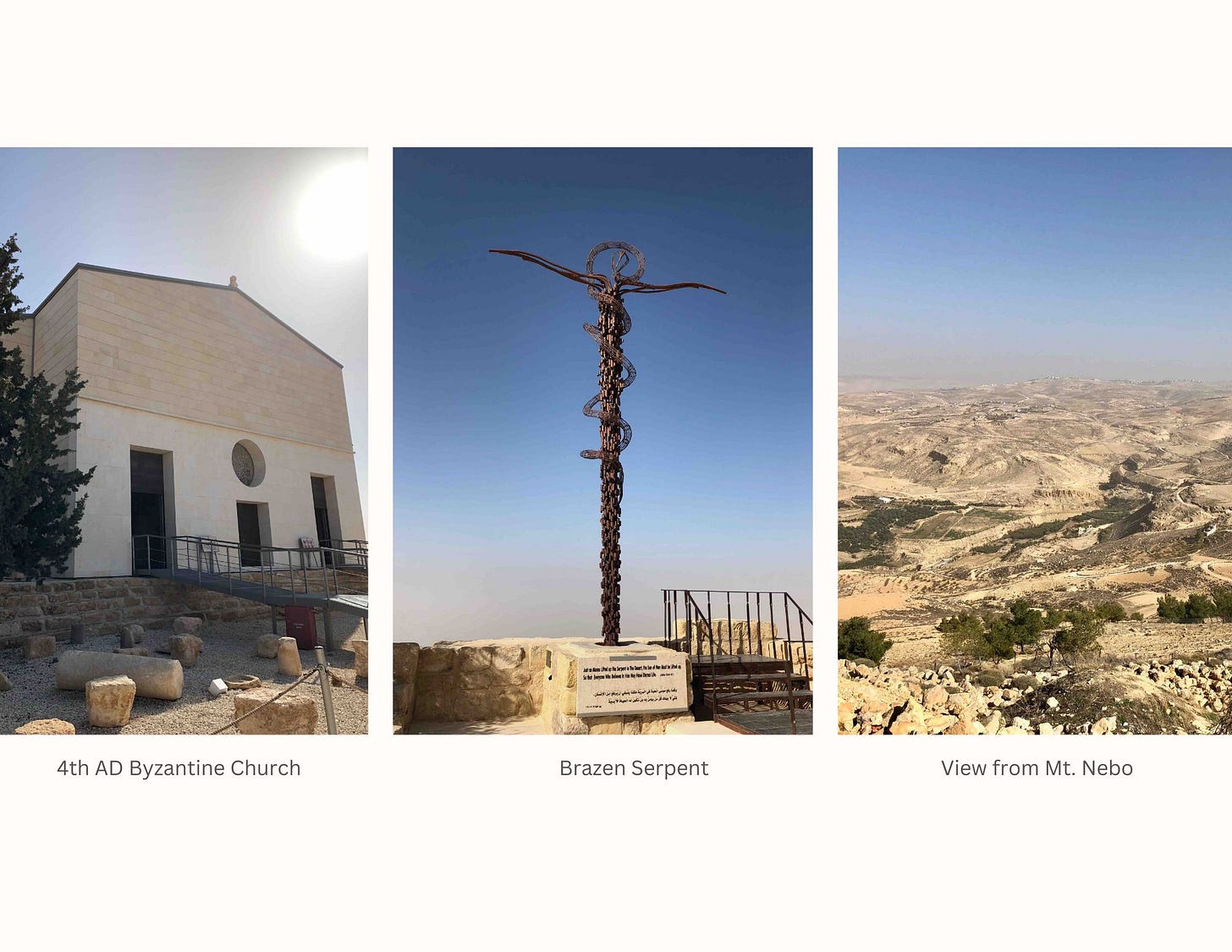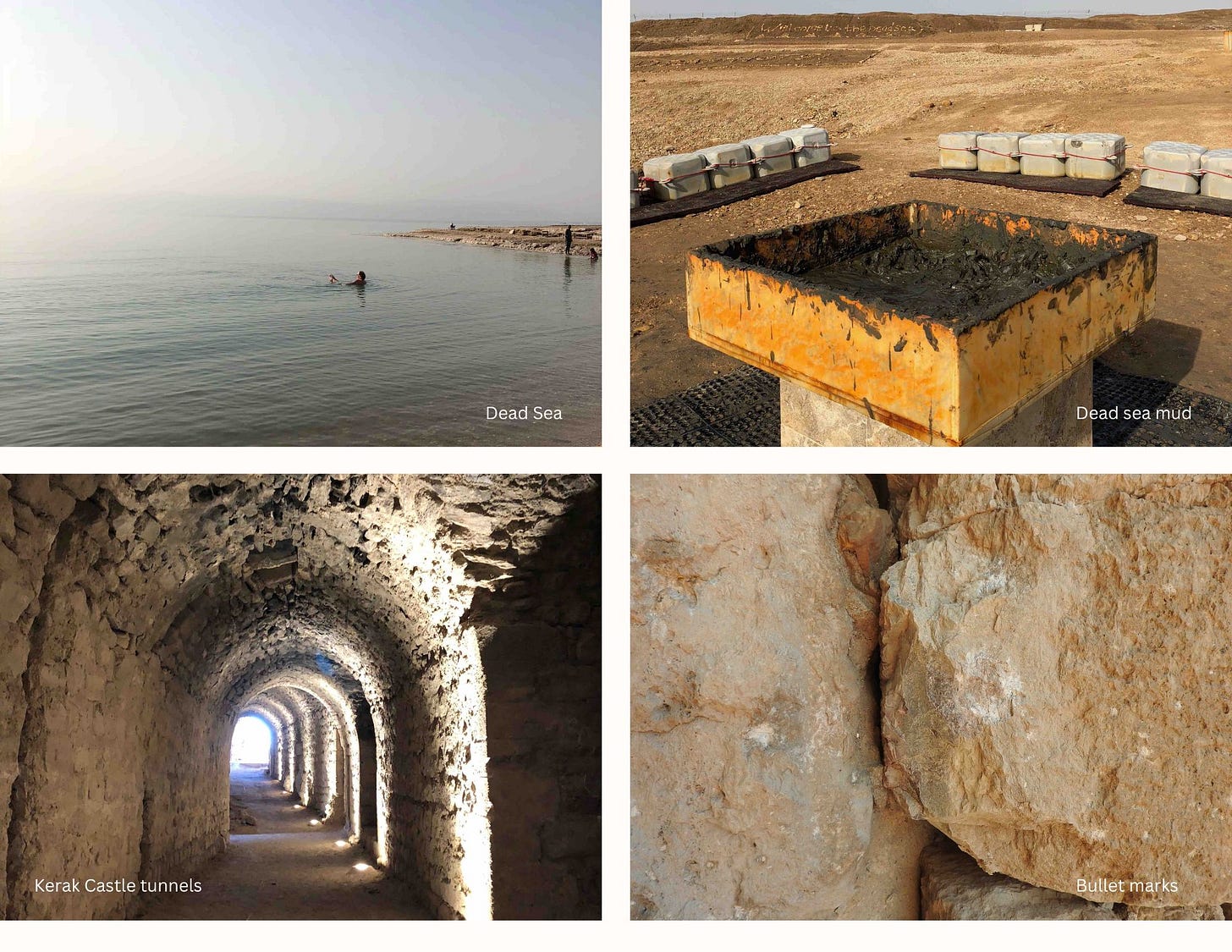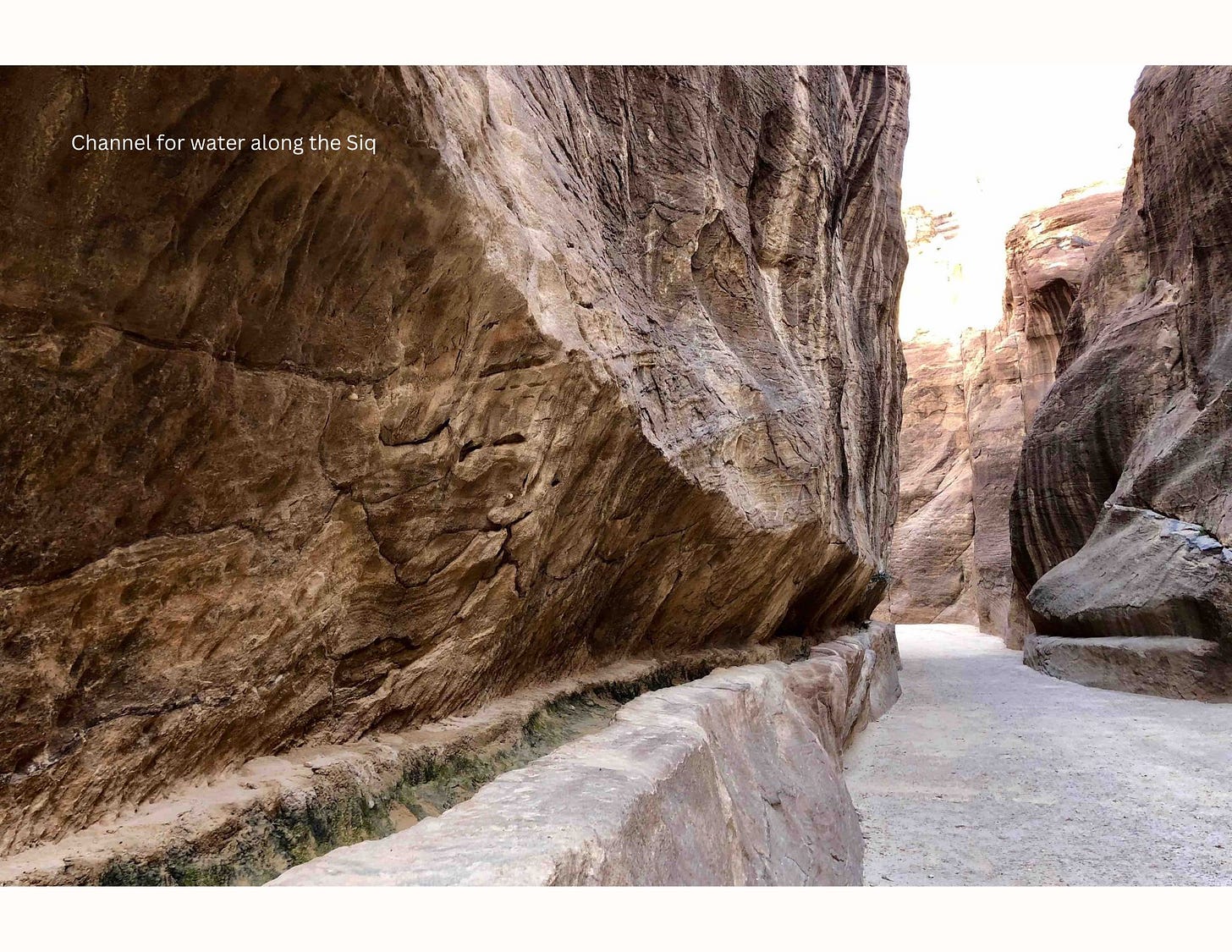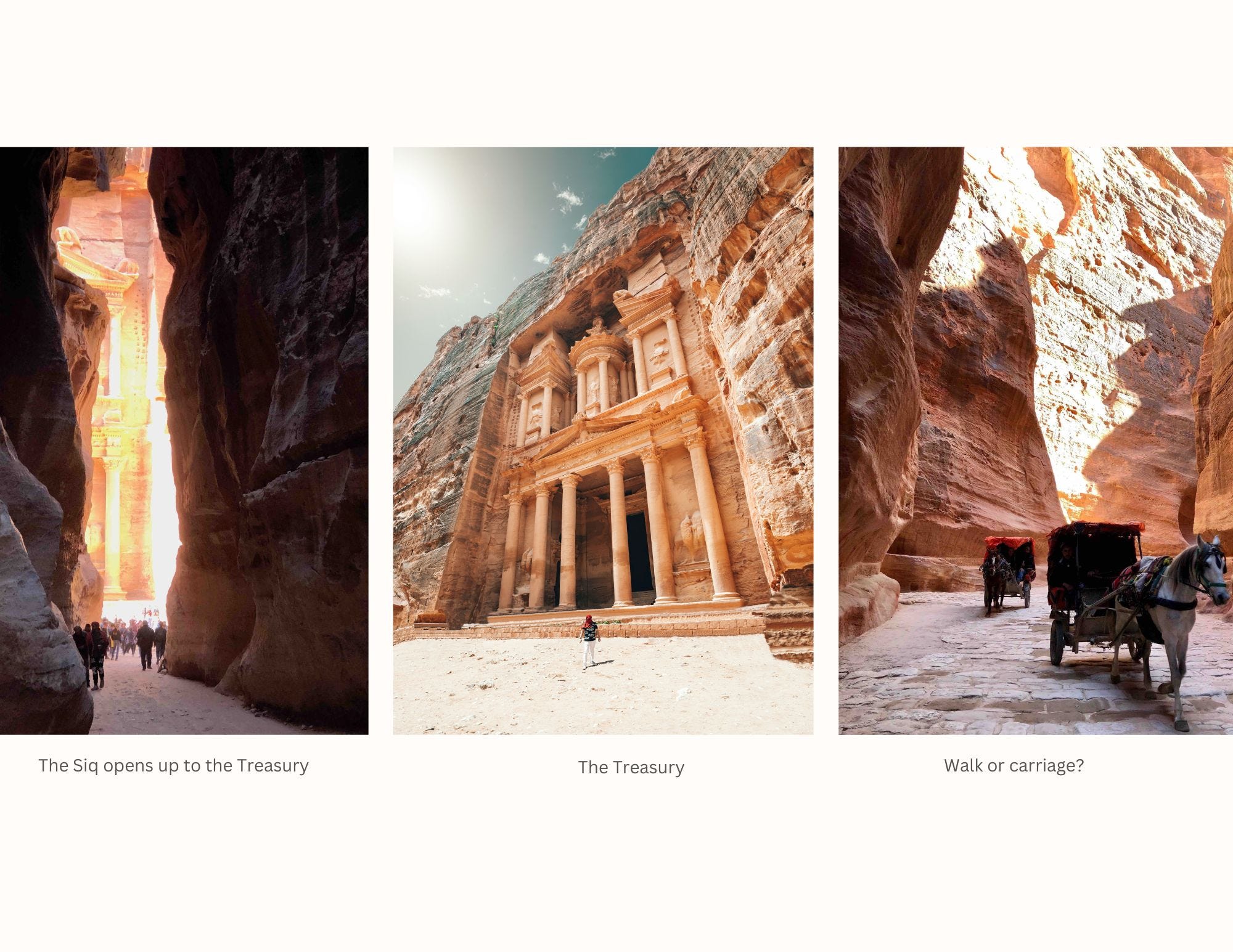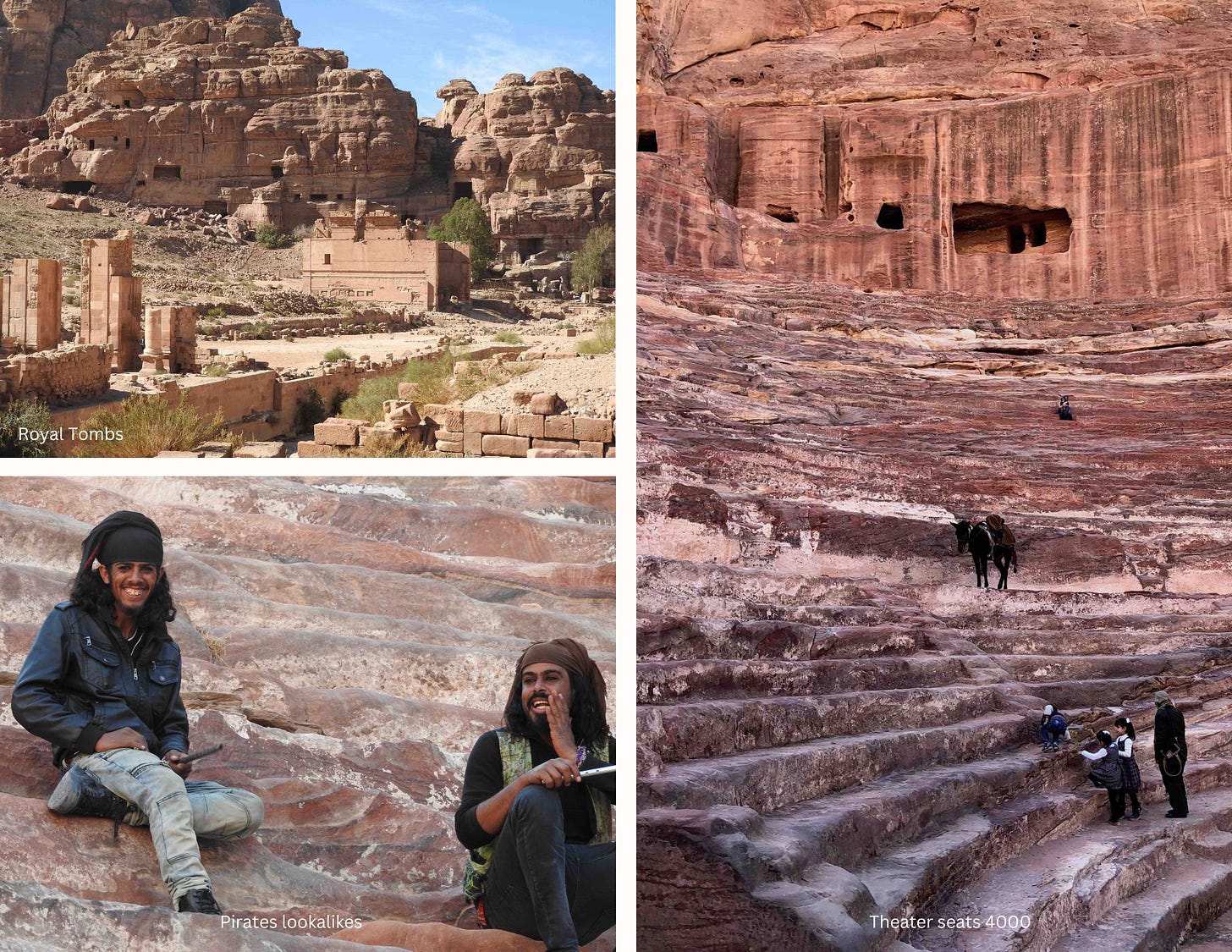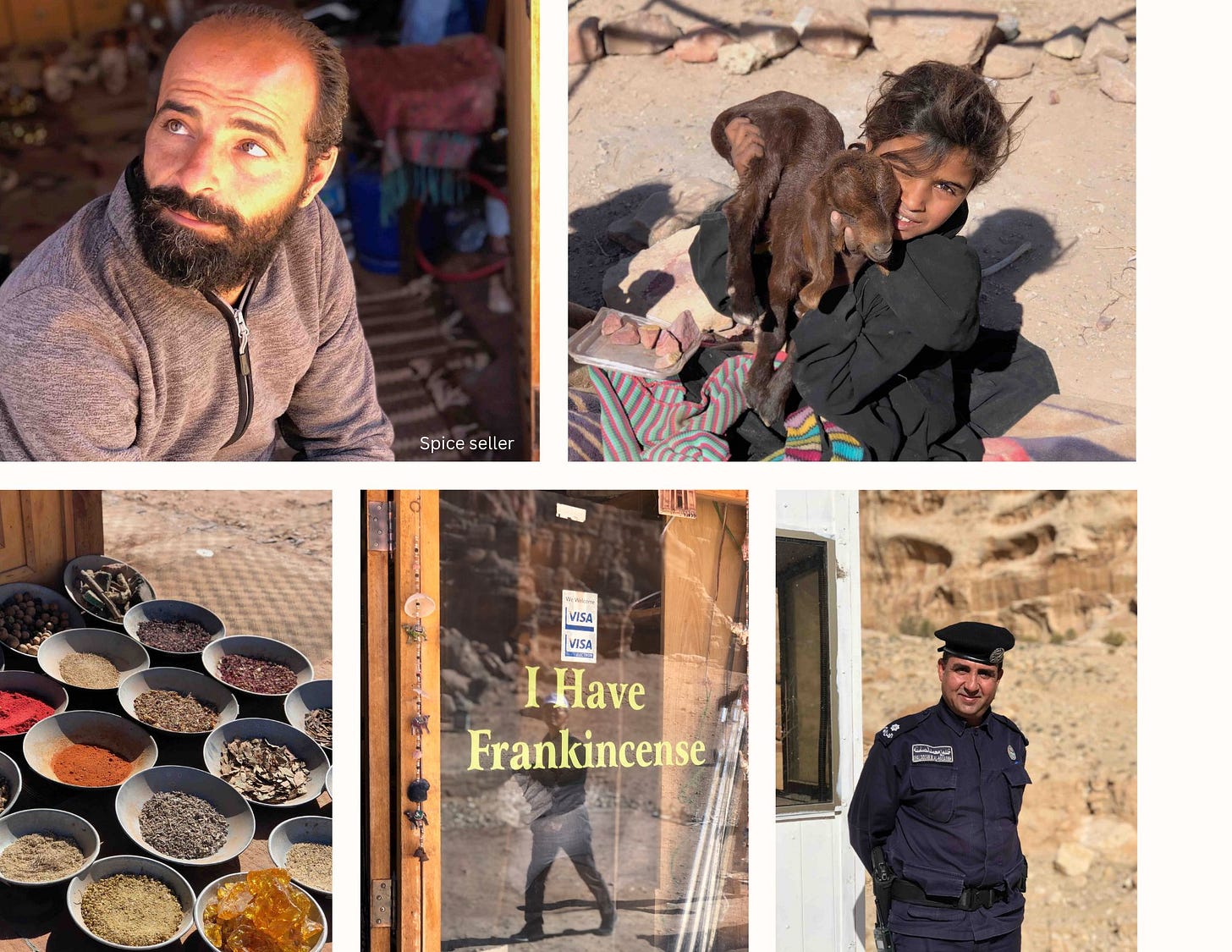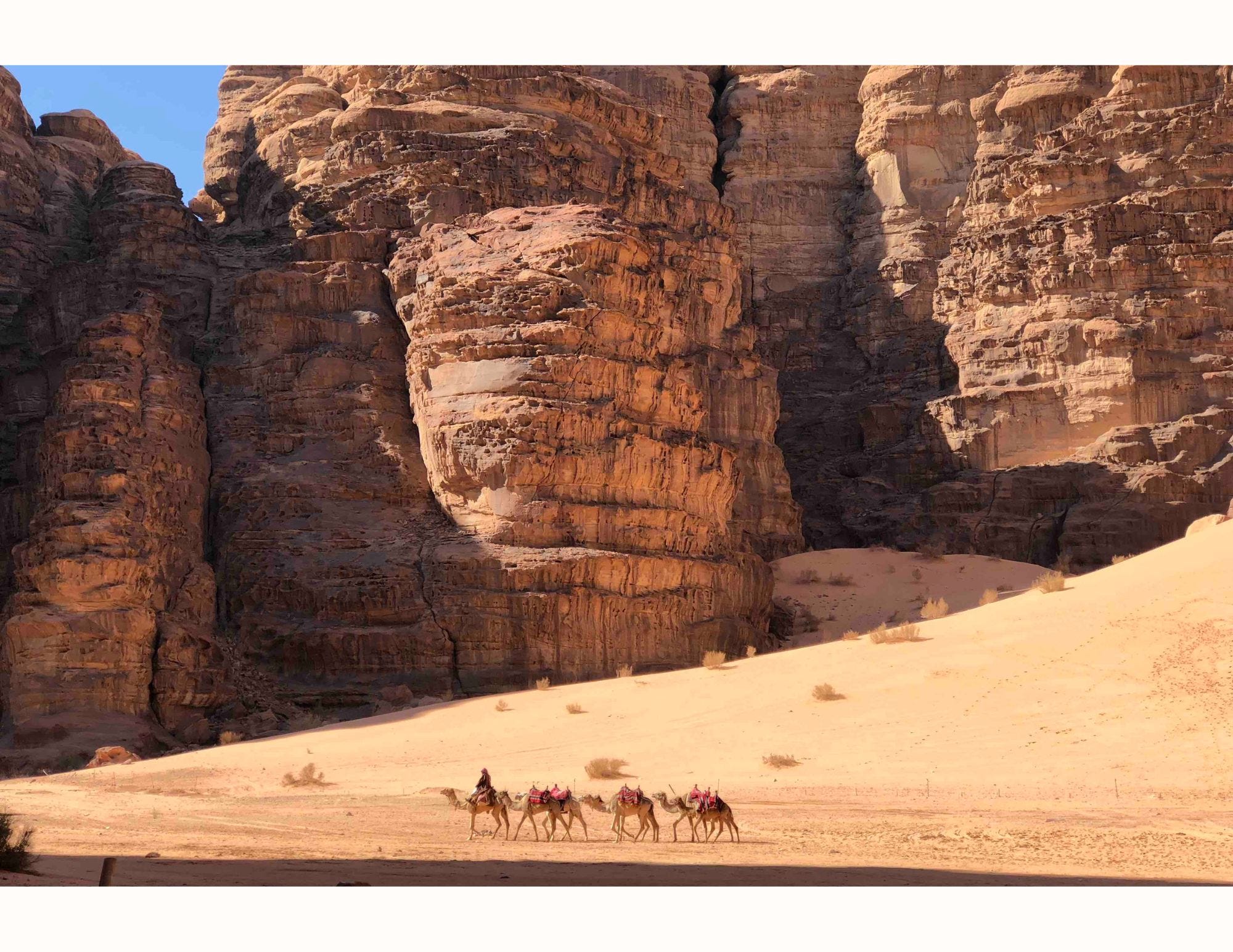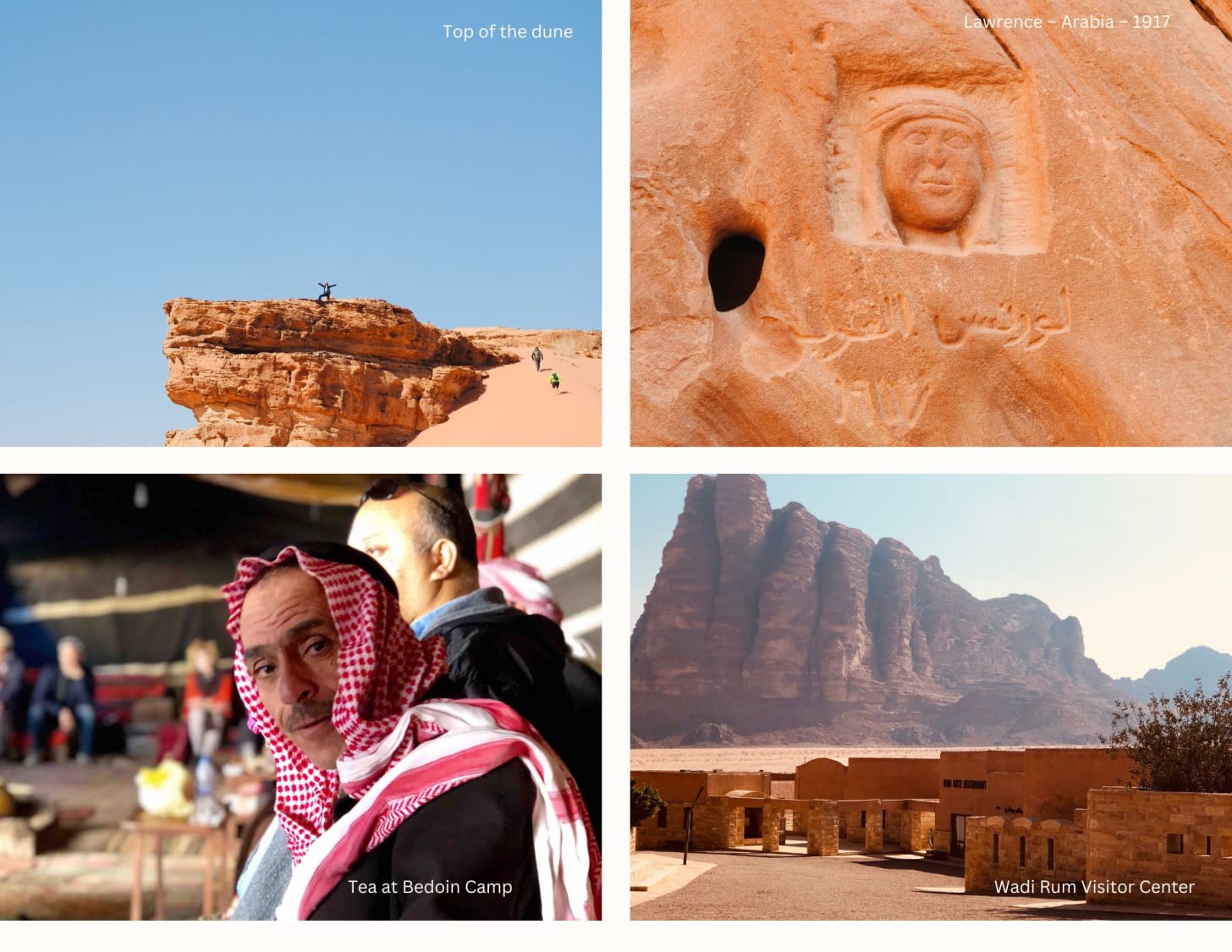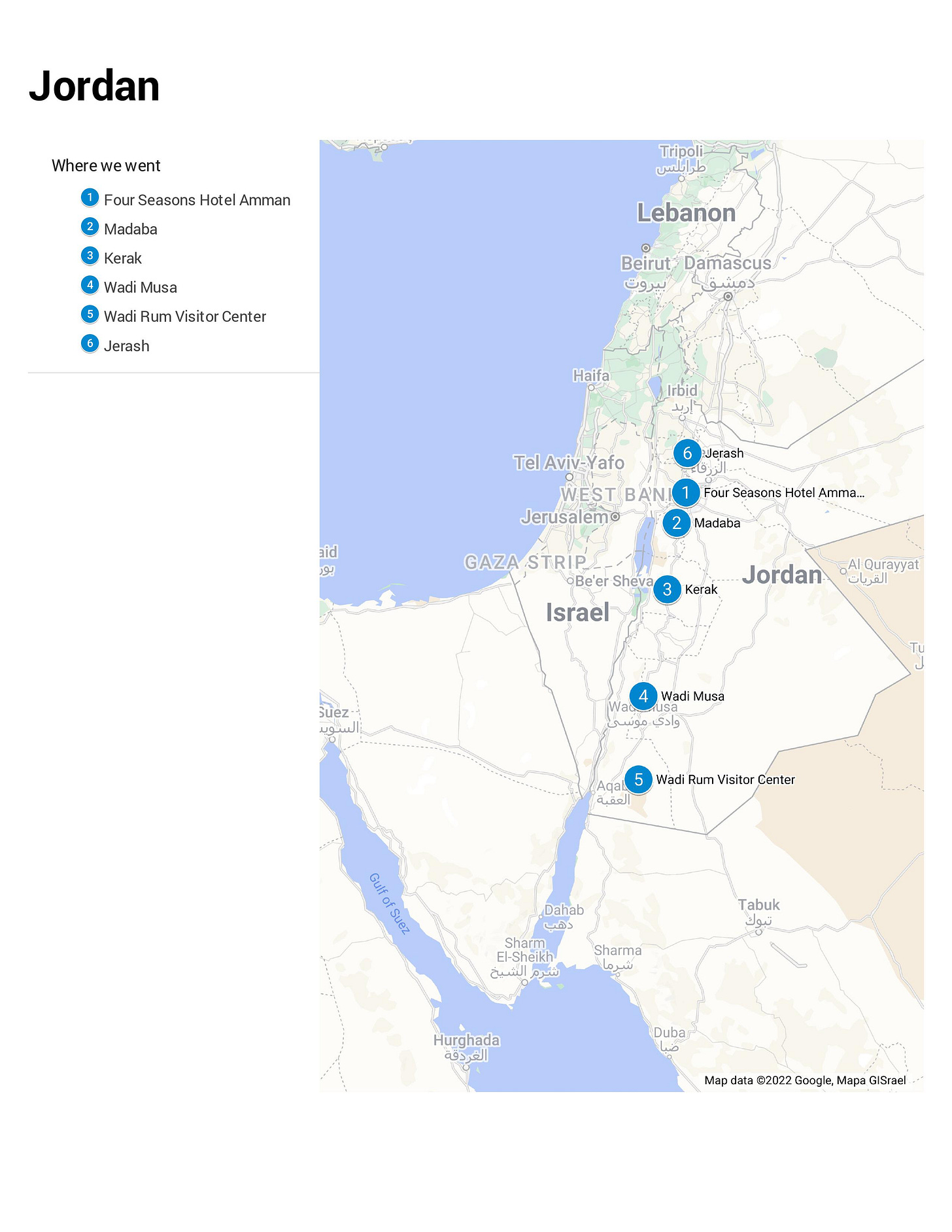You’re receiving this email as a subscriber to A Voyagist Newsletter. Thank you!! If you know someone who may enjoy it, please pass it along!
Not everyone has a bucket list. I do, and you might consider one. Jordan and the places T.E. Lawrence haunted have always been high on mine. Lawrence of Arabia, the movie by David Lean, and the books such as Seven Pillars of Wisdom by Lawrence himself are things I have gone back to many times.
When we decided to join our friends in Oman on our way home from Kenya, we knew they were coming from Jordan and the magical Petra. We decided it wasn't that far to add it in, and well…far enough as it is nearly a 5-hour flight north.
We left Oman in the early evening, landing in Amman late. We smartly arranged a car through our hotel to avoid confusion at the airport. All worked out nicely, and we were upgraded to a suite courtesy of our Hotel booking membership—lots of nice upgrades from them on this trip.
Amman
In the morning, we headed for Citadel Hill, the highest point in Amman, which has been occupied since the Bronze Age. More recent occupants were the Romans, who built the Temple of Hercules on the site during their occupation of Jordan in 162-166 AD. You can't miss Hercules's giant hand (three fingers and an elbow). It is estimated to have been over 40 feet high; there is nothing else left. A guide said the rest of Hercules became Amman's countertops. Great views of Amman, including the 6,000-seat Roman theater below the hill. There is a fantastic little museum where every piece on exhibit is quite frankly amazing. One sculpture of two heads is carbon-dated to 6,500 BC!!! Since you are surrounded on all sides by Amman, there was a moment when the Call to Prayer went out simultaneously from what must have been hundreds of mosques. Perhaps that is where surround sound came from.
The Citadel is the one place you must see in Amman.
Amman, known as the White City due to the use of local white limestone for building, is the capital of the Hashemite Kingdom of Jordan and is home to 2 million people. It feels like more, as the traffic is horrible. More touring to Rainbow Street, supposedly a center for shops and cafes, was a bust. It felt like there was nothing much else to see in Amman once you did The Citadel. But there is a whole lot to see in the rest of Jordan.
After an excellent dinner at our hotel, early the following day, we headed off in the direction of Petra with our freelance tour guide Aladdin. Yes, his name was really Aladdin. We had two possible routes. The Desert Highway is pretty much featureless but will get you to Petra in just over 3 hours. The Kings Highway, an old trading route that meanders up and down mountains, through villages and historic sites, can take twice as long or more with stops. Well worth it to spend the extra time; the King's Highway is not to be missed.
Spend the extra time; the King's Highway is not to be missed.
Our first stop was in the village of Madaba. Here you find the Christian Church of St. George, famous for its 6th-century mosaic floor map of Jerusalem and all of the Holy Lands. The highlight is a map (see below), made from over 2 million pieces of colored mosaic stones, of all the familiar spots (Dead Sea, Israel, Palestine, The River Jordan, etc.); it is remarkably accurate. No drone overhead views in the 6th century unless those pesky aliens did it.
Onward to Mount Nebo. This is the spot where God spoke to Moses and told him he could finally die at the ripe old age of 120. He had spent 40 years leading the Israelites out of Egypt and another 40 settling them down in their new digs. It is a drop-dead gorgeous restored church with views up the Rift Valley to Hebron, Jerusalem, and even Palestine. And yes, it is the Rift Valley. A continuation of the same one we were at in Kenya just ten days before and thousands of miles away. Once again a gorgeous little museum on site (Jordan does this exceptionally well), and the views are just amazing. There is also a reproduction of The Brazen Serpent, a staff that Moses used to save his people from snakes that God sent as punishment for their lack of faith. We missed the spot past here where Salome tricked King Herod's son to "bring me the head of John the Baptist. Ah, well.
Touring on from Nebo, we noticed several burned-out houses, 4 or 5 in one small village. Aladdin commented on the fires and told us these were "revenge" killings. This area remains very tribal, and if your father kills my son, a vendetta against the family can continue for years. A couple of other houses had permanently parked police cars out front as they were targeted for "revenge ." Jordanian authorities have tried to eliminate this for decades, but it continues to this day.
Our next stop is Kerak, a famous Crusaders’ palace. It is better known than others in the region as it is the place where the vicious French mercenary Commander Raynald de Chatillon held off a siege by Sultan Salladin in 1184. De Chatillion escaped but was later captured by Salladin, who executed him personally. Kerak is also known for the terrorist attack of December 18th, 2016, where five ISIS terrorists occupied the castle after getting in a shootout with local police in the nearby town. There were many tourists in the castle at the time, but most were in another section. Still, a Canadian woman tourist was killed and several more injured before authorities killed all the terrorists losing over a half dozen of their own men in the process. Some things change in the Middle East, and some never do. There were horrible killings here 5,000 years ago and again a few years ago, as the bullet marks on the entrance wall confirm. Senseless, yes, but we always felt completely safe in Jordan. This attack was a rare occurrence and never repeated.
Kerak is possibly the best example of a Crusader castle in the Middle East.
Descending into the valley from Kerak, we passed…. nothing. There is nothing but rocks, sand, and the occasional Bedouin camp and their goatherds. Eventually, as you climb up the hills, you see huge wind farms as Jordan is committed to developing new power sources to supplement their limited oil deposits. After an hour, we reached the Dead Sea and stopped for lunch at one of the many resorts. Ellen and I walked down to the beach, and I dipped one finger in the water as we watched a few folks floating unassisted, reading a paper. The taste was a shock as the water is 34% salt. We also noticed great concrete containers full of Dead Sea Mud that are supposed to have curing properties. We abstained. There are apparently some stunning hotels on the Dead Sea, the Kempinski Hotel Ishtar being one. However, it was January, and it was very quiet. Although we did stop at a hotel, we think it was some deal Alladin had with the owners. I won't name it; very 3-star and rather shabby.
From The Dead Sea, we drove for another two hours passing massive potash mines and processing plants, a mainstay of the Jordanian economy. That economy is pretty devastated by the over 2 million Syrian refugees in camps on its northern and western borders. Jordan fronts 65% of the cost of maintaining them, the rest by donations. Credit to them and King Abdullah. Even though his Father, King Hussein, did support the Arab cause in the Six-Day War, he was the first of the Arab countries to sign a peace treaty with Israel.
Delayed by hanging out at Kerak, we pulled into Wadi Nusa, the town fronting the Petra site, after dark missing the view from the road up from the valley. We moved into the recommended hotel in town, the Movenpick. There are others, but this one is right across the street from the entrance to Petra. Too late for anything but a snack. We pulled out all the winter clothes we had been carting around for three weeks. It was cold, less than 10 degrees.
The warnings about the weather seemed to be true. At 8:00 am, it was cold and very gray. But, by the time Aladdin showed up an hour later, patches of blue sky appeared, and when we began the long walk down to The Siq, it was blue skies all the way. The Siq is a natural cut in the limestone running downhill at a 5% grade. Siq means "Shaft" in Arabic. It is an incredible experience to walk the 1.2 KM with sandstone walls over 46 meters tall and the width in places narrowing to just 3-4 meters. The sandstone floor has been supplemented by flagstone in areas to stop erosion, and the echoing clip-clop of the donkey-led carriages can be heard long before they bear down on you. Actually, you can smell them at about the same time you can hear them.
The Nabateans built Petra in the 4th century BC. Enterprising people, they took advantage of the overland trading routes and made Petra a hub and themselves rich in the process. They grew Petra until, in the 1st century AD, it had 20,000 inhabitants. It didn't last long. In 108 AD, the Romans, jealous of Petra's success, invaded and captured the city. After an earthquake in 363 AD severely damaged the site, and sea routes were replacing the old overland trade routes, Petra was largely abandoned by 700 AD. It wasn't until more than 1,100 years later, in 1812, that a Swiss explorer named Johann Burkhardt disguised himself as a Bedouin, snuck into Petra, and his notes and drawings were made public. Today it is a UNESCO World Heritage site, which used to get 1 million visitors a year. The region's instability cut that in half, and only last year did visits hit 600,000, and it will go up from there.
The Nabateans survived and thrived due to their ability to manage their limited water. On average, this area only gets 9 inches of rain a year. So, they carved elaborate channels into the base of the Siq to capture every drop of water that fell. These channels led to 80 cisterns at the bottom of the natural 5% grade. Normal rainfall was supplemented by very occasional flash floods, where again, the locals also captured every drop. The channels are still there, remarkably intact and running, on both sides of the Siq, for the entire 1.2 KM of its length.
The Siq opens up abruptly at the signature photo op: The Treasury. Carved into the sandstone face, it is almost perfect from a distance; by setting it back from the face, away from wind and rain, it reduces erosion. They also channeled water from above it, away from the carving. Close up; you can tell one of the six columns has been replaced (you can tell because it doesn't look as good as the five original columns still standing). It is also pockmarked by centuries of bullet holes by raiders trying to get to the wealth hidden inside. Except, there wasn't any. The Treasury is misnamed; it was actually thought to be a tomb as additional excavation revealed a number of large tombs one level below.
The Siq opens up abruptly at the signature photo op: The Treasury.
It is January, and while we are under pure blue skies and peeling off layers of winter clothes in the sun, there is nothing that can be done about the smell. On this day, about 200 people milled about in front of the Treasury, but there were also at least 40 donkeys and almost the same number of camels. And this is the low season! I can't imagine summer with 10 or 20 times the tourists, many more animals, and temperatures that can hit 40 Degrees C.
Going in winter is a risk, but summer must simply be awful.
We were surprised that off to the right of The Treasury is Wadi Musa, or the Valley of Moses in Arabic. The valley opens up, and you walk downhill for at least another 2 KM. The first thing you see is a massive theater cut into the stone that seats 4,000. It sits at the widest point of the valley facing the giant tombs cut into the hillside opposite. Local boys are hanging out and are dead ringers for Captain Jack Sparrow from 'Pirates of the Caribbean.' There are four tombs, each with doorways big enough to take a double-decker bus side by side. Farther up the valley is the colonnade of the Great Temple, the real focal point of Petra's government. High in the hills above is the Monastery, the religious center accessible either by a donkey or a brutal 2 hour uphill climb. We passed as it was going to be a very long walk back up to Wadi Musa.
We met a British guy who lives in the ruins. He sells spices packaged up for tourists. It was here that I realized the pungent smell (not donkeys) that followed us around Jordan was Frankincense. I came to really like the sweet, musty aroma, and we bought a small chunk from Yemen for $30 dollars. By small, I mean about half of a bar of soap. I keep it in my sock drawer, and the aroma wafts out every morning. We also came upon a small jewelry shop run by a New Zealand woman, Marguerite van Geldermalsen, a nurse who came to Petra in 1978 and married a Bedouin. She had three children with him and still lives part of the year in a 2,000-year-old cave in the valley. She wasn't around, but we met one of her sons and bought her book, aptly named "Married to a Bedouin."
The walk back up the valley and then up The Siq was tough on old knees but SO much better than being behind one of those stinking donkeys. The sandstone takes on fantastic colors in the afternoon light, and it is all framed by an azure blue sky. Petra. Fantastic.
Tip. You really can do Petra in one day. A long day but it's all you need. Bring a bottle of water and wear good walking shoes. I would do two days if I were to do it again. There are lots to see and more to come as excavations continue.
Wadi Rum
The following day we packed up again and headed south to Wadi Rum. This is the desert area where Lawrence of Arabia roamed with his Arab army, hounding the Turks and blowing up their troop and supply trains in 1917. The movie was partly shot there, as was The Martian. Ellen was skeptical. Just more desert? On arrival an hour later, we realized this was something very special. You stop at a quite nicely done visitors center where Aladdin met up with our tour guy and his open-bed 4WD pick-up with benches in the back. In a few minutes, we left civilization behind (not that there was much of it) and headed into towering sandstone cliff-lined sand valleys under those same gorgeous blue skies. Colder today; we finally got to wear all the winter clothes we had carted around for the last three weeks.
Wadi Rum is just as special as Petra. Don’t miss it.
How to describe it? Moonscape? Martian-scape? Film set? Here, quite different from Petra, the sandstone cliffs have eroded in a way that makes them look like melted candles. There are no trees, no bushes really, and no people in evidence except for small Bedouin camps and a few goats. There are other 4WDs, about a dozen, but there can be many, many times more in the summers. We all stop at an outcrop of rock with a natural sand ramp to the top on the backside. I am not one for slogging uphill in the sand, but Ellen went for it. She reached the top with aching legs but did it for the perfect photo waving from the top of the outcrop.
It was all about the same after that. We drove down valleys and around mountains ending at a natural blockage where we stared out onto the sand between rock walls, looking toward Saudi Arabia 50 km away. But there was one last treat in store.
We stopped at a Bedouin camp for their delicious tea brewed over an open fire. Aladdin told me that Lawrence of Arabia used this little canyon as a hideout between attacking Ottoman Turk trains with his Arab army. He took me to a large sandstone rock where Lawrence's face was carved into the front with an inscription in Arabic: "Lawrence – Arabia – 1917." I had my Lawrence moment.
Tip: There are more than a dozen luxury camps hidden away in Wadi Rum, and some are more lux than others. The best is Bedu, where the tents are on movable platforms to minimize damage to the land, power is provided by solar, and you can hike, dune bash in 4x4s, take a hot air balloon or ride a camel. I've done the camel thing, never again.
Aqaba from Wadi Rum is only 76 km. Aqaba is Jordan's only Red Sea port and fast becoming a major tourist destination as it is a duty-free, tax-free zone. It was made famous by Lawrence of Arabia's victory over the Turkish garrison in 1917.
Jerash is to the north of Amman, just 48 km away. The long-buried Greco-Roman city was discovered in 1925, and excavations continue to this day. The town hosts the annual Jerash Festival of dance and music, including chariot races and mock gladiator battles. The event takes place over three weeks in July and attracts thousands of visitors. In fact, Jerash is the number 2 most visited site after Petra.
Touring this area is like taking a walk through history and a Hollywood film set simultaneously. Where else would you find where Moses walked, Lawrence of Arabia roamed, and where "that scene" from Raiders of the Lost Ark was shot: all in one day?
(Visited 2018, updated 2023)




